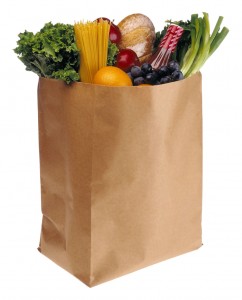Ask Shelley Case: Help with Creating Healthy, Nutritious (& Exciting!) Gluten-Free Meals
Monday, September 13th, 2010 Question: I am on a gluten-free diet and need help with meal planning. Do you have any suggestions on making meal time a bit more exciting by adding more variety? P.S. – Healthy & nutritious ideas are a plus too!
Question: I am on a gluten-free diet and need help with meal planning. Do you have any suggestions on making meal time a bit more exciting by adding more variety? P.S. – Healthy & nutritious ideas are a plus too!
Successful gluten-free meal planning requires a positive attitude, a little creativity and learning how to make substitutions for some ingredients and food items in favorite recipes and menu items. Fortunately, many foods that are naturally gluten-free are also good for you, including plain meats, fish, poultry, eggs, milk, cheese, yogurt, legumes (dried beans, lentils and peas), nuts, seeds, fruits, vegetables, and grain alternatives such as amaranth, buckwheat, corn, flax, millet, quinoa, rice, sorghum and teff. In addition, there are numerous gluten-free specialty products (e.g., pasta, breads and baked goods, cereals, sauces, soups) that can be substituted for traditional gluten-containing items.
In the beginning, plan simple meals and snacks with plain foods so you don’t become overwhelmed with the new gluten-free lifestyle. But, once you have mastered the basics gradually incorporate new items and try more complex dishes with multiple ingredients. Have fun! To save time and energy, prepare gluten-free recipe and menu items that everyone can eat rather than having to “cook twice.” Other family members can supplement their meal plan with gluten-containing bread or dessert items if desired.
The trick is to keep an optimistic attitude, be creative, and embrace trying new (and exciting!) foods!
Here are some specific ideas on how to add variety and incorporate more nutritious options into the gluten-free diet:
| Breakfast Boosters | ||
| If you eat this… | Add this… | Or try this instead… |
| Cream of white rice cereal | Nuts, seeds, ground flax,dried fruits, or fresh fruit | Cream of brown rice, cream of buckwheat, amaranth, rolled oats (pure, uncontaminated gluten-free), quinoa flakes, or teff |
| Puffed rice or corn cereal | Fresh fruit | GF granola with nuts, seeds, ground flax, dried fruits |
| GF white rice bread or bagel | Nut butter, cheese, poached egg, or omelet with chopped vegetables | GF enriched bread or bagel; or make your own bread and substitute brown rice, ground flax, bean flours, almond flour or Montina TM for some of the white rice, cornstarch, tapioca starch or potato starch |
| Fruit beverage or fruit drink | Fresh or frozen fruit or fruit juice plus yogurt or skim milk powder and ground flax seed to make a fruit smoothie | Calcium-fortified juice or 100-percent fruit juice |
| GF waffle or pancakes with syrup | Cottage cheese or yogurt and fruit | Substitute almond flour, brown rice, buckwheat, bean flour, ground flax, mesquite flour, oat flour (pure, uncontaminated, gluten-free), quinoa or teff flour for some of the white rice flour. |
| Crepes made with white rice flour and topped with syrup | A filling made with blended ricotta cheese, lemon or orange zest, and small amount of sweetener; a topping of berries, peaches, or other fruit, and maple syrup | Substitute almond or bean flour for some of the white rice flour |
| Fried egg and bacon | Low-fat mozzarella or feta cheese, veggies, and GF smoked salmon, turkey, or ham to make an omelet | Omega-3 rich egg; use a non-stick pan; try Canadian bacon or low-fat GF turkey or chicken sausage |
| Power Lunches and Dinners | ||
| If you eat this… | Add this… | Or try this instead… |
| Chicken rice soup | Fresh or frozen vegetables | Soups made with lentils, dried beans or peas, vegetables (squash, pumpkin, tomato) |
| White rice pizza crust, salami and cheese | Vegetables such as peppers, onions, zucchini and tomatoes | Add some amaranth or brown rice flour to your dough; use low-fat cheese |
| White rice pasta with butter or margarine | Low-fat cheese and vegetables | Enriched gluten-free pasta, brown rice, or quinoa pasta; use less butter or margarine |
| White rice bread sandwiches, butter or margarine, mayonnaise and luncheon meat | Sprouts, lettuce, tomatoes, avocado, shredded carrots | GF enriched bread or bagel; low-fat mayonnaise, salsa, or mustard; salmon, tuna. low-fat GF deli meats such as chicken, turkey, pastrami or ham |
| White rice and meat, fish or chicken | Fresh or frozen vegetables | Brown rice or a combination of brown, wild, and white rice; quinoa, buckwheat, millet or teff |
| Baked or mashed potato with butter or margarine | Cheese and chopped veggies such as broccoli in the baked potato; milk and grated low-fat cheese in the mashed potato | Use yogurt or low-fat sour cream instead of butter or margarine; try a sweet potato for more Vitamin A |
| Iceberg lettuce salad, GF croutons, cucumbers, and celery with salad dressing | Tomatoes, peppers, cauliflower, broccoli, mushrooms, shredded carrots, chickpeas, sunflower seeds | Romaine or spinach with strawberries or mandarin oranges, toasted slivered almonds, and/or sesame seeds with a fruit dressing or low-fat salad dressing |
| Smart Snacks | ||
| If you eat this… | Add this… | Or try this instead… |
| GF pretzels | Unsalted nuts | Trail mix with GF granola, dried fruits, nuts and seeds |
| Rice cakes or rice crackers | Cheese (cubes or string), hummus, nut butter with banana or apple slices | GF snack bar made with seeds, dried fruits and healthy GF grains (amaranth, flax, quinoa); GF high-fiber snacks made with nuts or seeds |
| Fried corn chips | Salsa and shredded cheese | |
| Celery sticks | Peanut butter, cheese spread or low-fat cream cheese with raisins | Carrot or turnip sticks, peppers, cherry tomatoes, broccoli or cauliflower |
| GF cookie | Fresh fruit and a glass of milk or enriched GF dairy substitute | Add brown rice, flax or quinoa to the recipe; choose ready-made cookies that are lower in sugar and fat or made with non-hydrogenated oils |
| GF brownie | Mug of warm, steamed milk or enriched GF dairy substitute | GF crispy rice square (still not so nutritious, but often less fat) |
| GF muffin with white rice flour | Chopped nuts, mashed banana, dried fruit (raisins, cranberries, apricots, dates); ground flax | Pumpkin, pineapple. carrot or banana muffins made with some brown rice flour, almond flour or bean flour. |
| Full-fat fruit-flavored yogurt | Fresh fruit and nuts | Plain low-fat yogurt with chopped fruits, nuts and a small amount of sweetener |
Reprinted and adapted with permission from: Rate Your Plate, Living Without magazine, Fall 2003, pg. 26. Chart prepared by Shelley Case, RD
Ask Shelley Case is a feature of BeFreeForMe.com. It is published the second Tuesday of each month. Shelley Case is a Registered Dietitian, Consulting Dietitian, Speaker and Author of Gluten-Free Diet: A Comprehensive Resource Guide. Visit Shelley and get more gluten-free tips & info at: www.glutenfreediet.ca
